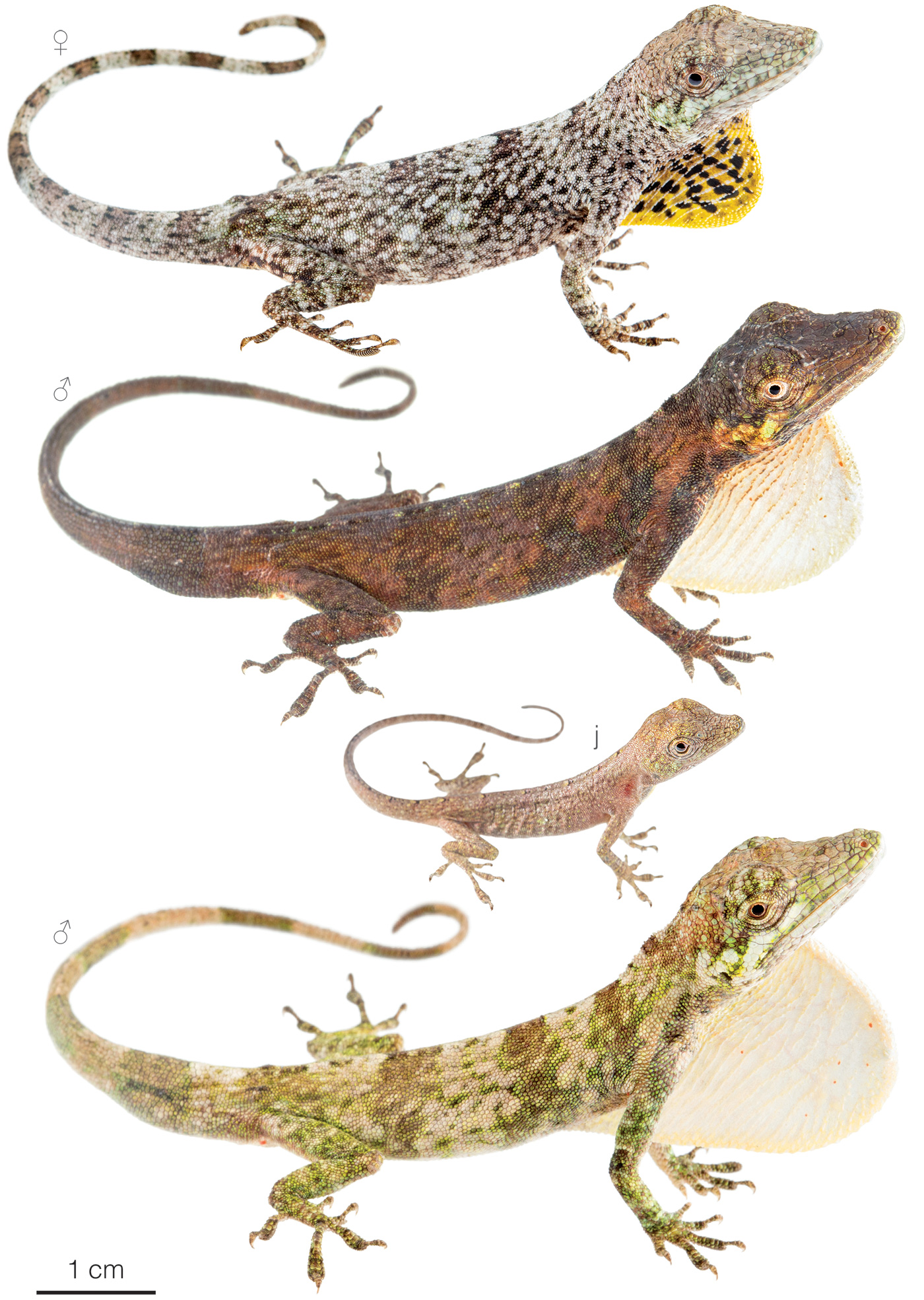Published May 22, 2023. Open access. | Purchase book ❯ |
Losos’ Anole (Anolis lososi)
Reptiles of Ecuador | Sauria | Anolidae | Anolis lososi
English common name: Losos’ Anole.
Spanish common name: Anolis de Losos.
Recognition: ♂♂ 13.9 cmMaximum distance from the snout to the tip of the tail. Snout–vent length=6.1 cm. ♀♀ 13.5 cmMaximum distance from the snout to the tip of the tail. Snout–vent length=6.0 cm..1 Anoles are easily distinguishable from other lizards by their diurnal habits, extensible dewlap in males (can be present in females also), expanded digital pads, and granular scales on the dorsum and belly.2,3 The Losos’ Anole (Anolis lososi) can be identified from other co-occurring anoles based on its small body size, short tail (about 1.2x SVL), short limbs, smooth head scales, and its dewlap coloration.1 In males, the dewlap is white; in females, it is yellow with black spots (Fig. 1). The most similar anole in eastern Ecuador is A. williamsmittermeierorum, but males of this species have a tan dewlap with peach-orange distal edge and females have a whitish dewlap with black spots.1,4

Figure 1: Individuals of Anolis lososi from San Francisco Research Station, Zamora Chinchipe province, Ecuador. j=juvenile.
Natural history: Anolis lososi is a locally frequent, but rarely seen, diurnal and arboreal lizard that inhabits the understory and canopy of old-growth to moderately disturbed cloud forests as well as forest remnants along creeks.1,5 Most individuals of this species have been found at night, roosting on twigs, ferns, and narrow leaves 2–8 m above the ground.1,5 One was seen moving in a twig-like motion on a Piperaceae bush during the daytime.6 This species can be included in the “twig” anole guild because it has a comparatively small SVL (~6 cm snout-vent-length), a short weakly prehensile tail (≤1.5 SVL), and very short legs (0.5 SVL). Losos’ Anoles are similar to other phenacosaur anoles in that their movements resemble those of a chameleon.
Conservation: Data Deficient There is inadequate information to make an assessment of extinction risk.. Anolis lososi is a recently described species; therefore, its conservation status has not yet been formally evaluated by the IUCN. Here, it is proposed to be included in the DD category because there is inadequate information to make an assessment of its extinction risk based on its scarce distribution data. The species is only from two localities (Fig. 2) separated from each other by areas having adequate cloud forest cover, suggesting it might be present elsewhere.
Distribution: Anolis lososi is endemic to the Amazonian slopes of the Andes in Ecuador. The species has been recorded at elevations between 1550 and 1971 m (Fig. 2).

Figure 2: Distribution of Anolis lososi in Ecuador. The star corresponds to the type locality: Romerillos Alto, Zamora Chinchipe province. See Appendix 1 for a complete list of the presence localities included in the map.
Etymology: The generic name Anolis is thought to have originated from Cariban languages, specifically from the word anoli, which is the name Arawak peoples may have used to refer to this group of lizards.7 The specific epithet lososi honors American evolutionary biologist and Herpetologist Jonathan B. Losos, who has dedicated his life to the study of anole lizards.1
See it in the wild: Due to their arboreal habits, Losos’ Anoles are usually overlooked by most visitors to the cloud forests of southeastern Ecuador. However, these anoles are common at the type locality and easy to locate in a specific patch of trees where individuals have been spotted previously. The area with the greatest number of observations is the San Francisco Research Station. Although active during the daytime, individuals can be spotted more easily at night, as they are asleep, roosting on vegetation, and their bright white belly can be made to stand out against the black night by shining a light on them.
Special thanks to Jonathan Losos and Joe Steensma for symbolically adopting the Losos’ Anole and helping bring the Reptiles of Ecuador book project to life.
Click here to adopt a species.
Author: Alejandro ArteagaaAffiliation: Fundación Khamai, Reserva Arlequín, Ecoruta Paseo del Quinde km 56, Santa Rosa de Mindo, Pichincha 171202, Ecuador.
Photographer: Jose VieirabAffiliation: Tropical Herping (TH), Quito, Ecuador.,cAffiliation: ExSitu, Quito, Ecuador.
How to cite? Arteaga A (2023) Losos’ Anole (Anolis lososi). In: Arteaga A, Bustamante L, Vieira J (Eds) Reptiles of Ecuador: Life in the middle of the world. Available from: www.reptilesofecuador.com. DOI: 10.47051/TNOM1174
Literature cited:
- Torres-Carvajal O, Ayala-Varela FP, Lobos SE, Poe S, Narváez AE (2017) Two new Andean species of Anolis lizard (Iguanidae: Dactyloinae) from southern Ecuador. Journal of Natural History 52: 1067–1089. DOI: 10.1080/00222933.2017.1391343
- Peters JA, Donoso-Barros R (1970) Catalogue of the Neotropical Squamata: part II, lizards and amphisbaenians. Bulletin of the United States National Museum, Washington, D.C., 293 pp.
- Castañeda MR, de Queiroz K (2013) Phylogeny of the Dactyloa clade of Anolis lizards: new insights from combining morphological and molecular data. Bulletin of the Museum of Comparative Zoology 160: 345–398. DOI: 10.3099/0027-4100-160.7.345
- Poe S, Latella I, Ayala-Varela F, Yañez-Miranda C, Torres-Carvajal O (2015) A new species of phenacosaur Anolis (Squamata; Iguanidae) from Peru and a comprehensive phylogeny of Dactyloa-clade Anolis based on new DNA sequences and morphology. Copeia 103: 639–650. DOI: 10.1643/CH-14-127
- Field notes, Reptiles of Ecuador book project.
- Felipe Serrano, pers. comm.
- Allsopp R (1996) Dictionary of Caribbean English Usage. Oxford University Press, Oxford, 776 pp.
Appendix 1: Locality data used to create the distribution map of Anolis lososi in Ecuador (Fig. 2). Go to the section on symbols and abbreviations for a list of acronyms used. Asterisk (*) indicates type locality.
| Country | Province | Locality | Source |
| Ecuador | Zamora Chinchipe | San Francisco Research Station | Torres-Carvajal et al. 2017 |
| Ecuador | Zamora Chinchipe | Romerillos Alto* | Torres-Carvajal et al. 2017 |